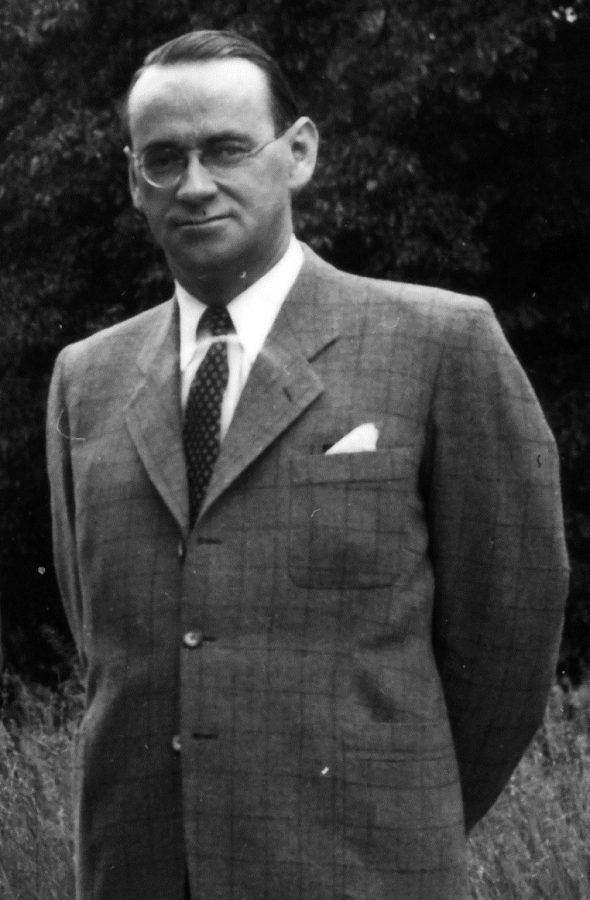Holocaust hero had early roots in St. Louis
Published January 30, 2020
On March 18, 1934, the St. Louis Post-Dispatch ran a short announcement entitled, “Chancellor of Swiss Consulate to Wed.” The chancellor, Carl Lutz, was engaged to another Swiss immigrant, Gertrude “Trudi” Fankhauser, and the two returned to Switzerland later that year to wed. Lutz was in St. Louis for only a short time but forged lasting connections in the city. He worked in an office on Seventh Street and lived in the Statler Hotel, now the Marriott St. Louis Grand.
In isolation, the two-paragraph announcement is of little importance to most of us. The newlyweds returned to Europe and never lived in the United States again. However, it’s Lutz’s later work that makes this announcement, and what it reveals about his connections to St. Louis, invaluable.
Holocaust Remembrance Day on Jan. 27 marked the 75th anniversary of the liberation of Auschwitz. This spring will also mark the 125th anniversary of the birth of Lutz — who is of no known relation to the author. Years after his departure from St. Louis, Lutz launched the largest civilian rescue mission of the entire Holocaust. His story, however, is little known in the city he once called home.
Lutz immigrated to the United States in 1913 and worked for several years in a factory in East St. Louis. In 1919, he enrolled in Central Wesleyan College in Warrenton, Mo., but transferred to George Washington University a short time later, hoping to pursue a diplomatic career. Following his graduation from GW in 1924, Lutz served in various diplomatic posts throughout the United States, including one in St. Louis from 1933-1934.
Lutz departed the United States in 1934 with his new wife after receiving an appointment in Mandatory Palestine, then a territory under British rule. After the outbreak of World War II in 1939, the neutral diplomat was tasked with negotiating the release of 2,500 Germans who found themselves de facto prisoners of war. He worked long hours and impressed his superiors. Praise for his work even reached the Fuehrer’s office in Berlin.
Lutz then turned to assist Jews in Palestine who held German passports, and he was able to procure protective papers from the British that allowed their holders to remain in exile in Palestine.
In 1942, Lutz transferred to Budapest, where he lived when the Nazis arrived in Hungary in March 1944. In the course of about six short weeks, Nazi forces and their Hungarian collaborators sent nearly 438,000 Hungarian Jews to Auschwitz. About 90 percent were murdered upon arrival.
Lutz recalled the protective papers he had used to assist German Jews in Mandatory Palestine and determined that they could be utilized to protect Hungarian Jews from being sent to Auschwitz. While it was unlikely that anyone could find a way from Budapest to Palestine in the chaos and terror of 1944-45, those who possessed the papers were considered under Swiss protection and exempt from deportation.
Lutz was able to procure 8,000 protective papers or “units” — which had already been printed and authorized by the British – but realized that his efforts would be for naught if he did not ensure the Nazi forces ruling Hungary would honor them. He learned that he should speak with a high-ranking Nazi official who had just arrived in Budapest: Adolf Eichmann.
Eichmann was a bit taken aback by the request from the well-dressed, albeit soft-spoken diplomat. He even used their initial meeting as an opportunity to mock Lutz, comparing him with Moses attempting to rescue his people. However, Eichmann did pass on the request. Soon after, Lutz received word that the 8,000 protective papers would be authorized by the Third Reich, in part because of Lutz’s previous work in Mandatory Palestine.
Lutz immediately launched a plan to rescue far more than 8,000 people. While Eichmann assumed that the 8,000 “units” Lutz requested meant 8,000 individuals, Lutz instead determined that “units” meant “families,” thereby increasing the number of people he would be able to protect. Immediately, he began to disseminate the papers throughout Budapest. He also placed 76 buildings under Swiss diplomatic protection, where he was able to house thousands of Hungarian Jews who had lost their homes and property. Lutz frequently stepped in to rescue individual Hungarian Jews, once jumping in the Danube river to rescue a Jewish woman shot by fascist militia.
In December, Lutz, his wife, and his staff took shelter in the basement of the British Embassy, which he was legally required to protect. Outside, the Red Army and Allied air support nearly razed Budapest. In early 1945, after spending two months in cramped and unsanitary conditions, the group was finally liberated. The Lutzes returned to Switzerland shortly afterwards.
Lutz was harshly criticized by his superiors and colleagues for his actions in Budapest. Switzerland refused to acknowledge Lutz’s rescue efforts officially until 1995, 20 years after his death. However, he was nominated for a Nobel Peace Prize three times. In 1963, Lutz was named “Righteous Among the Nations” by Yad Vashem, Israel’s official Holocaust memorial and museum. Trudi Lutz received the same honor in 1976.
The United States Holocaust Memorial Museum estimates that Lutz saved approximately 62,000 souls, making him responsible for the largest civilian rescue mission of the entire Holocaust. And yet, his story has been mostly lost to history. Too few of us in St. Louis know that this heroic man was once an active and connected member of our city.
Therefore, as we recentlly marked International Holocaust Remembrance Day, take time to remember the victims, remember the survivors and remember Carl Lutz.
Amy Lutz is a master’s degree student in history at the University of Missouri, St. Louis. In 2013, she graduated from St. Louis University with a bachelor’s degree in history. Lutz is also a docent at the Holocaust Museum & Learning Center of St. Louis.














